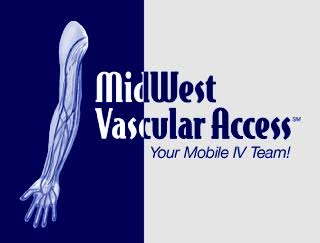Where can you find MWVA?

MidWest Vascular Access is the Midwest’s largest and most advanced mobile IV team, staffed entirely by Vascular Access Specialists. MidWest Vascular provides service in the Metropolitan Kansas City area and surrounding areas. We care for patients at every level of care, from the Intensive Care Unit to Home Health and Hospice. We also care for patients from childhood through end-of-life.
Midline Catheter
Midline catheters are peripheral venous access devices between 3 to 10 inches in length (8 to 25 cm). Modern versions of this device are typically 8 inches (20 cm) long. Midlines are usually placed in an upper arm vein such as the brachial or cephalic and the tip ends below the level of the axillary line. Midline catheters are longer than typical peripheral IV catheters which are generally 1 to 3 inches long and shorter than peripherally inserted central catheters (PICC) which extend into the vena cava. This device provides an alternative to short peripheral IVs for certain treatments. While the exact length of dwell time is not definitively restricted, midlines are routinely used for one to four weeks of IV therapy. Since the tip of these catheters does not extend beyond the axillary line, there are limitations as to the type of infusates that can be infused through this device, and the length of time it dwells (generally up to 28 days).
PICC: Peripherally Inserted Central Catheter
A PICC line is a long, flexible tube (catheter) inserted into a peripheral vein and advanced until the catheter tip terminates in the Superior Vena Cava (SVC), a large vein in the chest.
A PICC does not enter the heart; a common misconception. In adults, the catheter’s point of entry is usually the upper arm. In some cases, central venous catheters may be placed in the neck (jugular) for adults with current or impending kidney failure. The lower extremities may also be used in children who are not crawling or walking.
Using ultrasound technology to visualize a deep, large vessel in the upper arm, the PICC catheter is inserted by a specially trained and certified PICC nurse specialist. Post insertion at the bedside, a chest x-ray is obtained to confirm ideal placement. The entire procedure is done in the patient’s room decreasing discomfort, transportation, and loss of nursing care.
Jugular Central Catheter (IJ)
A Jugular central venous catheter (CVC) is commonly attempted to obtain central venous access for hemodynamic monitoring (such as central venous pressure), long-term administration of fluids, antibiotics, total parenteral nutrition and hemodialysis. Many anatomical landmark (LM)-guided techniques for IJV puncture have been utilized. More than 5 million central venous catheters (CVC) are placed each year in the United States, with an associated complication rate of >15%. The risk of complications depends on several factors, including (but not limited to) operator experience, urgency of placement as well as patient factors such as obesity, prior difficult cannulation and coagulopathy. It has been suggested that ultrasound (US) guidance could improve the success rate, reduce the number of needle passes and decrease complications. MidWest Vascular utilizes ultrasound guidance on 100% of all device placements to ensure that patients do not incur unnecessary needle sticks and complications.
Subclavian Central Catheter
A subclavian central line is a long-term vascular access device that’s insertion point is the midsubclavian area from the junction of the outer clavicle to the lowest point of the suprasternal notch. For insertion, the patient is placed in the Trendelenburg position to prevent air embolism and the face is turned to the left side. After giving local anesthesia, a long needle is first inserted to identify the blood backflush from the subclavian vein using a saline-loaded syringe, and then the skin is punctured with an introducer needle in the same way. The needle is advanced in the direction of the sternal notch until the tip abuts the clavicle at the junction of its medial and middle thirds. The needle is then passed beneath the clavicle, while hugging the inferior surface of the clavicle. Blood return may be achieved during withdrawal of the inner needle and the patient’s face is turned to the right side before insertion of the catheter to prevent catheter malposition to the internal jugular vein.
MidWest Vascular places Jugular central catheters at the bedside of the patient just as a typical PICC placement would be performed. The patients that MWVA places these particular lines for are patients who are not the typical PICC candidate. These patients include those on dialysis or those that may have the possibility to eventually require dialysis. All procedures of this nature are performed under the utmost compliance with the Standards of Practice while using sterile technique to make sure that your patients are cared for in the utmost variable-controlled environment.
Thrombolytic Declotting of CVC
Utilizing a declotting agent, MidWest Vascular can restore patency to your patient’s occluded CVC. This is done by infusing a declotting agent into the patient’s device and allowing it to dwell for up to two hours. This eliminates the cost and risk of completely replacing the line and avoids additional needle sticks. All facilities requesting a line to be declotted will need to obtain the physician order and medication from their contracted providers; it is not provided by MWVA.
 MidWest Vascular Access is the Midwest’s largest and most advanced mobile IV team, staffed entirely by Vascular Access Specialists. MidWest Vascular provides service in the Metropolitan Kansas City area and surrounding areas. We care for patients at every level of care, from the Intensive Care Unit to Home Health and Hospice. We also care for patients from childhood through end-of-life.
MidWest Vascular Access is the Midwest’s largest and most advanced mobile IV team, staffed entirely by Vascular Access Specialists. MidWest Vascular provides service in the Metropolitan Kansas City area and surrounding areas. We care for patients at every level of care, from the Intensive Care Unit to Home Health and Hospice. We also care for patients from childhood through end-of-life.
